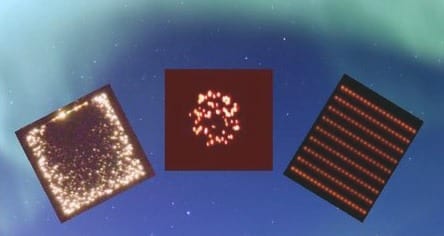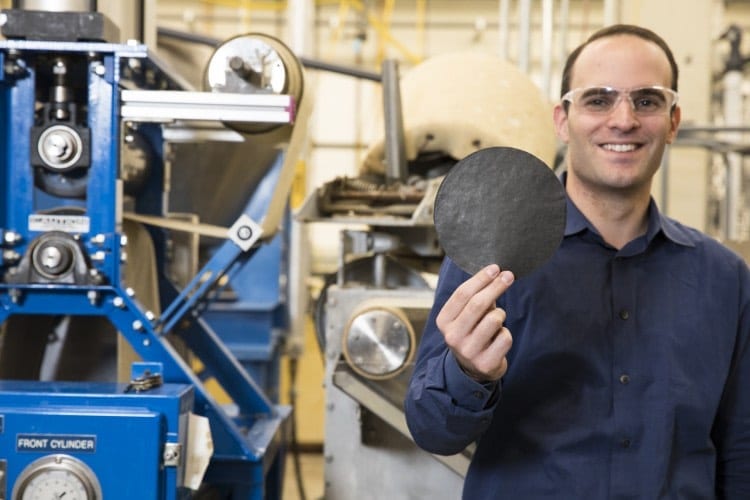
Electronics and light don’t go well together on a standard ‘CMOS’ chip. Researcher Satadal Dutta of the University of Twente succeeded in introducing a light connection into the heart of a semiconductor chip. In this way, two circuits can communicate. Or: the worlds of electronics and photonics are connected.
What is particularly attractive about Dutta’s solution is that no special materials or manufacturing processes are needed: the light comes from silicon. The light source, detector and the light channel can be made using the technology that is used to make the electronic circuits. Fully optical circuits are available nowadays, but they use materials like indium phosphide and gallium arsenide, which can’t easily be combined with the CMOS chip processes used for semiconductor chips you’ll find in today’s smartphones, for example.
Avalanche LED
The alternative would be: make a LED out of silicon. And that’s the problem: silicon only emits a tiny amount of infrared light, while a detector made out of silicon needs visible light. They are talking and listening at different wavelengths. Dutta therefore chooses a remarkable way out: connect the LED reverse. At low voltages, there’s no current, but at a voltage that is high enough, there will be a small current that amplifies itself like an avalanche. In this ‘avalanche mode’, the LED will transmit visible light. Using the same process, the light detector, as well as the light channel in-between can be made. Thanks to the special comb structure that Dutta designed, the light source gets more uniform and energy efficient.
Isolation
An optical link on a chip is a good way to ‘galvanically’ isolate two circuits from each other. This is often necessary in cases where one circuit is a low-voltage and low-current one, while the other is a high-power circuit. They should be connected, but not by conducting wires, for reasons of safety. A classic transformer is an option then, but an optical connection is often used as well. Until now, this is a separate ‘optocoupler’, which is large and has a limited bit rate. Dutta’s new solution is much more compact as an alternative: it total, it is just a few tens of microns and it offers the protection that’s needed. Compared to optical channels in full-optical circuits, the energy consumption is relatively high, as there is quite some scattering of light. On the other hand: designing the electronics around the optical link in an efficient way, the amount of light needed for a successful connection, can be kept to a minimum.
Connecting worlds
All-optical circuits may become the ‘new electronics’, predictions say. In the transition from electronic to optic circuits, hybrid circuits, like the one Dutta designed, could play an important role.
Learn more: When electronics and photonics meet on a standard chip
The Latest on: Electronics and photonics
[google_news title=”” keyword=”electronics and photonics” num_posts=”10″ blurb_length=”0″ show_thumb=”left”]- BE Semiconductor Industries N.V. Announces Q1-24 Resultson April 25, 2024 at 12:23 am
Revenue of € 146.3 Million and Net Income of € 34.0 MillionRevenue Exceeds Midpoint of Guidance and Gross Margin above GuidanceDUIVEN, the ...
- Ansys and TSMC Enable a Multiphysics Platform for Optics and Photonics, Addressing Needs of AI, HPC Silicon Systemson April 24, 2024 at 1:30 pm
Ansys (NASDAQ: ANSS) today announced a collaboration with TSMC on multiphysics software for TSMC's Compact Universal Photonic Engines (COUPE). COUPE is a cutting-edge Silicon Photonics (SiPh) ...
- MIT Technology Reviewon April 23, 2024 at 2:00 pm
Electrical engineer Nili Persits, PhD ’24, has developed low-cost Raman spectroscopy systems that allow instant chemical analysis.
- Scientists stencil-paint carbon nanotube components for flexible transparent electronicson April 23, 2024 at 9:23 am
Researchers from Skoltech, MIPT, and elsewhere have found a fast and inexpensive way to create geometric patterns in carbon nanotube films. The resulting films turned out to have superior properties ...
- Leveraging Cryogenics and Photonics for Quantum Computingon April 23, 2024 at 7:03 am
While sureCore focuses on cryogenics/cryogenic semiconductor design, Quantum Computing works on photonics-based technologies.
- CSA Catapult and SMD Semiconductor sign landmark collaboration agreementon April 23, 2024 at 5:05 am
Catapult and SMD Semiconductor have signed a memorandum of understanding (MoU) to work together in the design, prototyping and manufacturing of next-generation semiconductor and compound semiconductor ...
- MBRU To Host Photonics Middle East International Conference Dubai 2024 From Saturdayon April 19, 2024 at 3:19 am
( MENAFN - Dubai PR Network) Event is open to public, especially students and academicians ...
- POET Augments Investor Outreach Efforts and Announces Management Role Changeon April 17, 2024 at 5:00 am
POET has retained Hybrid Financial Ltd. (“Hybrid”) to connect the Company to a select group of technology investors identified from a database of over 1,400 buy-side funds in the United States and 200 ...
- The First Universal, Programmable And Multifunctional Photonic Chipon April 15, 2024 at 10:22 pm
The photonic chip enhances 5G, AI, and more, developed by researchers and already impacting telecommunications and tech industries.
- Research team manufactures the first universal, programmable and multifunctional photonic chipon April 15, 2024 at 9:32 am
A team from the Photonics Research Laboratory (PRL)-iTEAM of the Universitat Politècnica de València and the company iPRONICS have designed and manufactured a revolutionary chip for the ...
via Google News and Bing News










